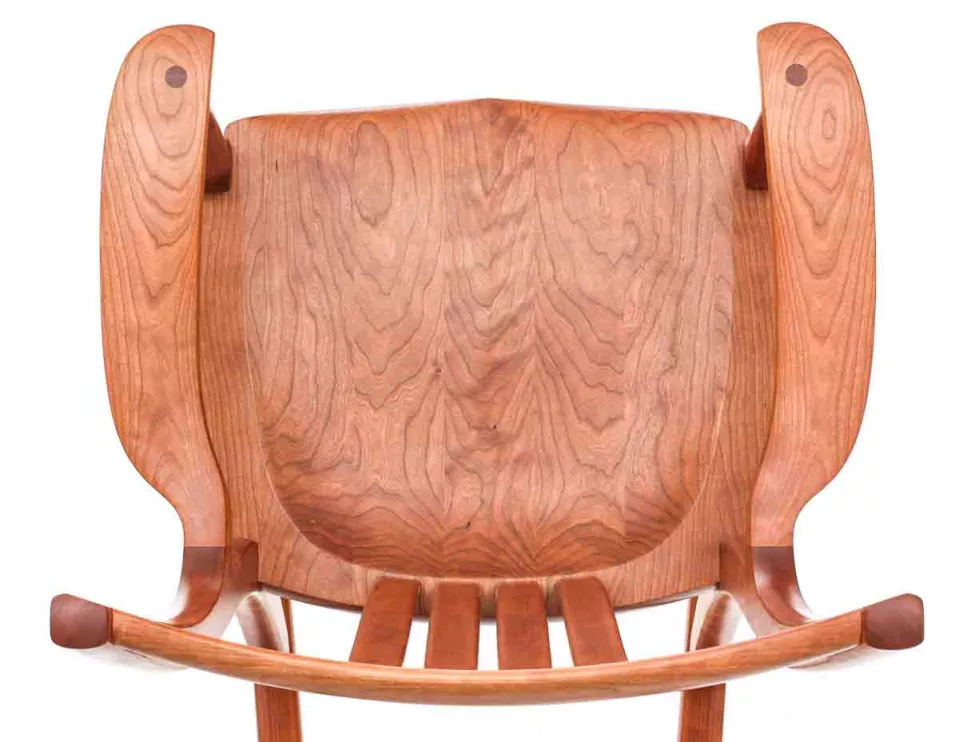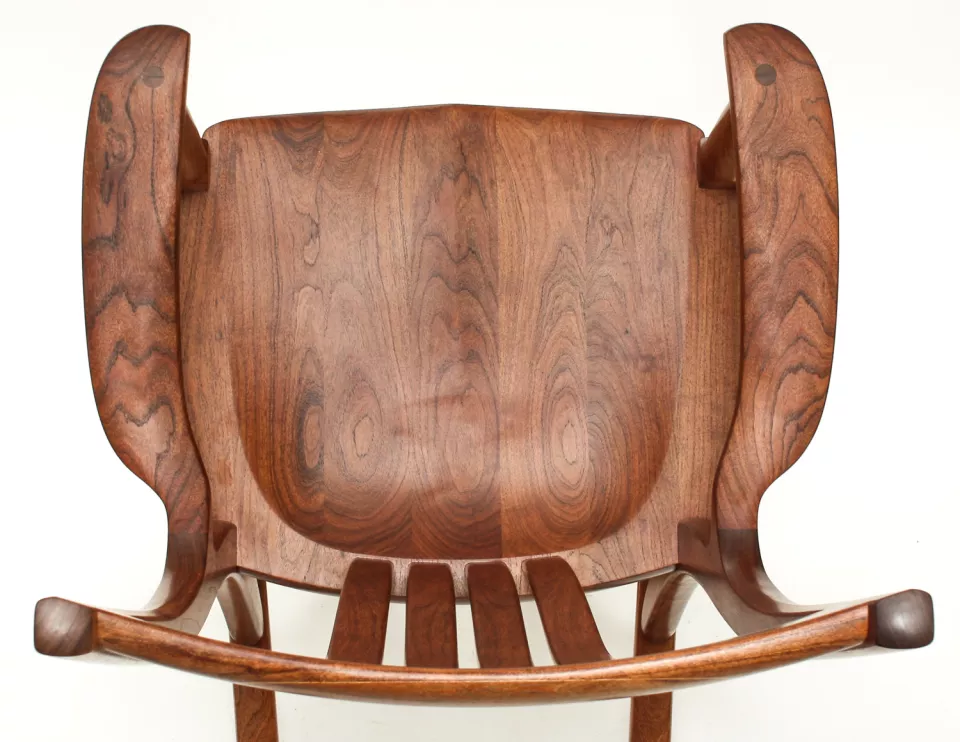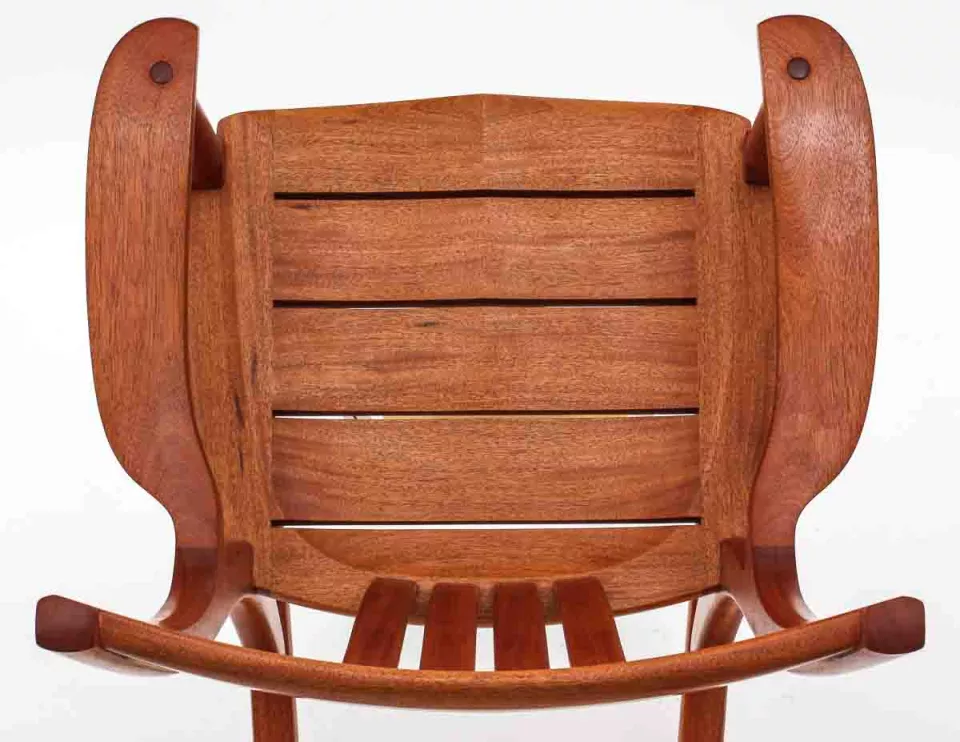The Woods We Use
We are fortunate to have these fine woods in the shed.
(And sometimes we work other species.)
Terms used on this page are defined on this page:
Cherry, Prunus serotina

A few scrappy cherry trees earn a meager living here in the Texas Hill Country. Occasionally, we harvest one, dying or blown over. It grows better northeast of here. Since 1998, our cherry has been supplied by Kane Hardwoods of Pennsylvania, where the trees can reach 80 feet in height with long clear trunks. The wood comes from forests certified to be well managed by the Forest Stewardship Council.
The wood is moderately dense, moderately hard, and moderately strong. The texture is very fine. The grain is closed. Cherry is very stable in use. The heartwood is reddish brown, somewhat light when fresh, but shortly becoming richer and darker in reaction to ambient light. The sapwood is a slightly yellow cream color. We sometimes match symmetrical splashes of sapwood into our compositions. Cherry often has marks of character: random dark streaks and flecks.
Cherry accounts for 4% of the hardwood harvested in the US.
Specific Gravity: .50
Walnut, Juglans nigra

Walnut is the nation's most valuable hardwood tree. A few grow here in the Texas Hill Country, associated with pecan in bottomlands or waterways. Occasionally, we work some Texas walnut. The trees do much better in the central and eastern US where the commercial walnut mills are located. Walnut trees can reach 70 feet in height, but are usually shorter and often branching. Because of its habit of growing alone or in small scattered groves and the special distribution system that has developed to capitalize on its high value, we do not have a source for FSC certified walnut. Since 2006, our walnut has been selected to our specifications by Irion Lumber.
Walnut is dense, hard, and strong. Its texture is fine. The pores are large enough to see in the early wood of its annual growth, making it open grained. The wood is stable in use. Because the best logs go to veneer and smaller, crooked, and branching logs go to lumber, there is much meandering of grain and many irregularities in the figure, making matching challenging and the results wilder. Irion does not steam walnut to darken the sapwood by lightening the heartwood. So, the heartwood is a deep, dark brown with a purple cast, and the sapwood is off white. As with cherry, we sometimes use the sapwood in contrasting display.
Walnut is 1.9% of the hardwood harvested in the US.
Specific Gravity: .55
Maple, Acer saccharum

The sugar maple, or hard maple, tree likes cold wet weather. We cannot accommodate it here in Texas. It grows in the northeastern US and Canada. The trees average 80 feet at maturity. Maple is associated with cherry and often grows in the same stands. The maple we use is almost always from forests certified by the Forest Stewardship Council.
Maple is very dense, very hard, and very strong--renowned for all three and its resistance to wear. The texture is very fine. There are no discernible pores, making it closed grain. Maple is less stable than cherry or walnut. We do not recommend maple for very dry or very humid conditions. In most places, it is certainly fine, but in the extremes there are cosmetic risks as two adjoining pieces may expand or contract at different rates. The sapwood is a creamy, off white and is a higher than average percentage of the trunk. It is sought and preferred. We don't use the brown heartwood (or at least where you can see it). Like cherry it has darker character marks.
Most maple trees are straight-grained, but some are spectacularly not so--resulting in curly maple and birds-eye maple. We build a few curly maple rockers and, from time to time, put some birds-eye parts as contrast in walnut or cherry chairs.
The harvest of hard maple is 4% of the US production of hardwood.
Specific Gravity: .63
Mesquite, Prosopis glandulosa, pubescens, and velutina.

The mesquite tree likes hot, dry weather. We can accommodate it here in Texas. It grows in the southwestern US and deep into Mexico, but wood of the best color and texture grows in south Texas. Most mesquite trees are thorny shrubs loathed by ranchers. Occasionally, a tree develops a trunk of useable size, but they are always short, crooked, branching, and full of defects. Useable wood is rare and expensive.
Mesquite is very dense, hard, and weak. Dense and weak is an unusual combination. There is a lot of mesquite wood fiber per volume, but the fibers are short, compromising toughness. We make special laminations and careful selections to insure the performance of our mesquite rocking chairs. The texture of the wood is fine. Small pores are visible: open grained. The wood is very difficult to dry, probably a result of an arid homeland. (Nothing in the brush country wants to give up its water.) Once dry, the wood is very stable. The grain is not straight--an understatement. Like the tree, the grain turns, twists, winds, wanders, rambles, and corkscrews. In a load of lumber, a long board is six feet long and a board with two clear faces is rare. The size of the lumber, the wild grain, and the numerous defects make matching difficult and the yield very low. The heartwood is a remarkably beautiful, rich red brown with unusual depth. The sapwood is bright yellow; it is susceptible to infestation with powder post beetles, even in homes. We make sure that no sapwood spends more than a few nights on the place, and we never put it in furniture.
Specific Gravity: .70
Genuine or Honduras Mahogany, Swietenia macrophylla

The range of Genuine Mahogany includes the tropical forest areas of Central and South America. Mahogany is often listed as the world's premier furniture wood, holding that reputation since the first logs went to Europe and dazzled the cabinetmakers. The species is endangered in many areas. The mahogany we use is certified by the Forest Stewardship Council, ensuring that it was grown in healthy forests and harvested at a sustainable rate.
Mahogany is moderately dense, moderately hard, and strong. The texture is fine. The pores are visible: open grain. The wood is very stable and resistant to decay. It has historically been used on boats and yachts. We use mahogany for the porch rocking chairs because of its stability and decay resistance. (Note the expansion joints in the seat.) The grain is usually straight, but sometimes wavy, giving the "ribbon stripe" effect. The heartwood is a medium reddish brown, surprisingly light when new, but darkening considerably in a short time. We receive little of the lighter sapwood.
Specific Gravity: .47
Sapele, Entandrophragma cylindricum

Sapele trees grow in tropical Central and West Africa, from Cote d'Ivoire to the Congo. They grow tall and straight and clear. Sapele is in the same scientific family as mahogany, Meliceae.
We use Sapele lumber for our porch rockers, because as of late 2023, we have been unable to get sustainably and ethically harvested genuine mahogany from the sources we had in Guatemala and Belize. Both woods are durable outdoors.
Sapele wood is rot resistant, moderately heavy, hard, tough, stable, and strong. Its texture is fine; its pores are open. The color is reminiscent of that of mahogany, but the figure is more pronounced. It is used for furniture, cabinetry, doors, windows, flooring, veneer, musical instruments, and boats.
Our supplier has this to say: "The Sapele lumber we provide to you is produced in the Republic of the Congo. We buy only from the most reputable importers. The trees are harvested and the lumber produced according to the standards of the Forest Stewardship Council. The lumber is the most remarkably consistent lumber we sell. We will stock and store to your specifications and quantity needs. You have the piece of mind of knowing your lumber is harvested and manufactured to FSC standards and you can message that to your client base. You are also helping a very economically challenged part of the world."
Specific Gravity: .56
